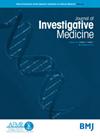EXPRESS:急性肺栓塞的预后预测模型。
IF 2.5
4区 医学
Q1 MEDICINE, GENERAL & INTERNAL
引用次数: 0
摘要
急性肺栓塞(APE)是重症监护病房中非常常见且重要的急症,预后不良。本研究旨在探讨APE的预后因素,并构建预后预测模型。本研究对 2020 年 1 月至 2024 年 3 月期间我院急诊科的 252 例 APE 患者进行了回顾性分析。最初的观察终点设定为患者入院后30天内的死亡状况。Cox多元回归分析用于确定预后的独立风险因素。根据这些因素,使用 R 软件构建并评估了提名图预测模型。入院 30 天内,42 名患者死亡,总死亡率为 16.6%(42/252)。二元 Cox 多变量回归分析表明,年龄≥ 62.5(HR:2.64,95%CI:1.23-5.63,P = 0.012)、右心室功能障碍(RVD)(HR:4.58,95%CI:1.76-11.96,P = 0.002)、白细胞计数(WBC)≥ 13.1(HR:2.35,95%CI:1.20-4.60,P = 0.013)、白蛋白/纤维蛋白原比率(AFR)< 9.15(HR:3.36,95%CI:1.76-6.42,P<0.001)、预后营养指数(PNI)<50.3(HR:4.35,95%CI:1.62-11.71,P=0.004)和全身炎症反应指数(SIRI)≥1.05(HR:7.21,95%CI:3.38-15.37,P<0.001)是死亡的独立危险因素。基于这些因素的提名图模型对 30 天死亡率具有良好的预测价值,AUC 为 0.908。基于年龄、RVD、白细胞、AFR、PNI 和 SIRI 的提名图模型对 APE 患者具有很好的预后价值。本文章由计算机程序翻译,如有差异,请以英文原文为准。
EXPRESS: A prognostic prediction model for acute pulmonary embolism.
Acute pulmonary embolism (APE) is a very common and important medical emergency in intensive care units with unfavorable prognosis. This study aims to explore the prognostic factors of APE and to construct a prognostic prediction model. A retrospective analysis was conducted on 252 APE patients in the Emergency Department of our hospital from January 2020 to March 2024. The initial observation endpoint was set as the mortality status of patients within 30 days of admission. Cox multivariate regression analysis were used to identify independent risk factors for prognosis. Based on these factors, a nomogram predictive model was constructed and evaluated using R software. Within 30 days of admission, 42 patients died with an overall mortality rate of 16.6% (42/252). Binary Cox multivariate regression analysis indicated that age ≥ 62.5 (HR: 2.64, 95%CI: 1.23-5.63, P = 0.012), right ventricular dysfunction (RVD) (HR: 4.58, 95%CI: 1.76-11.96, P = 0.002), white blood cell count (WBC) ≥ 13.1 (HR: 2.35, 95%CI: 1.20-4.60, P = 0.013), albumin/fibrinogen ratio (AFR) < 9.15 (HR: 3.36, 95%CI: 1.76-6.42, P < 0.001), Prognostic Nutritional Index (PNI) < 50.3 (HR: 4.35, 95%CI: 1.62-11.71, P = 0.004), and Systemic Inflammation Response Index (SIRI) ≥ 1.05 (HR: 7.21, 95%CI: 3.38-15.37, P < 0.001) were independent risk factors for mortality. The nomogram model based on these factors demonstrated a good predictive value for 30-day mortality, with an AUC of 0.908. The nomogram model based on age, RVD, WBC, AFR, PNI, and SIRI has a well prognostic value for APE patients.
求助全文
通过发布文献求助,成功后即可免费获取论文全文。
去求助
来源期刊

Journal of Investigative Medicine
医学-医学:内科
CiteScore
4.90
自引率
0.00%
发文量
111
审稿时长
24 months
期刊介绍:
Journal of Investigative Medicine (JIM) is the official publication of the American Federation for Medical Research. The journal is peer-reviewed and publishes high-quality original articles and reviews in the areas of basic, clinical, and translational medical research.
JIM publishes on all topics and specialty areas that are critical to the conduct of the entire spectrum of biomedical research: from the translation of clinical observations at the bedside, to basic and animal research to clinical research and the implementation of innovative medical care.
 求助内容:
求助内容: 应助结果提醒方式:
应助结果提醒方式:


